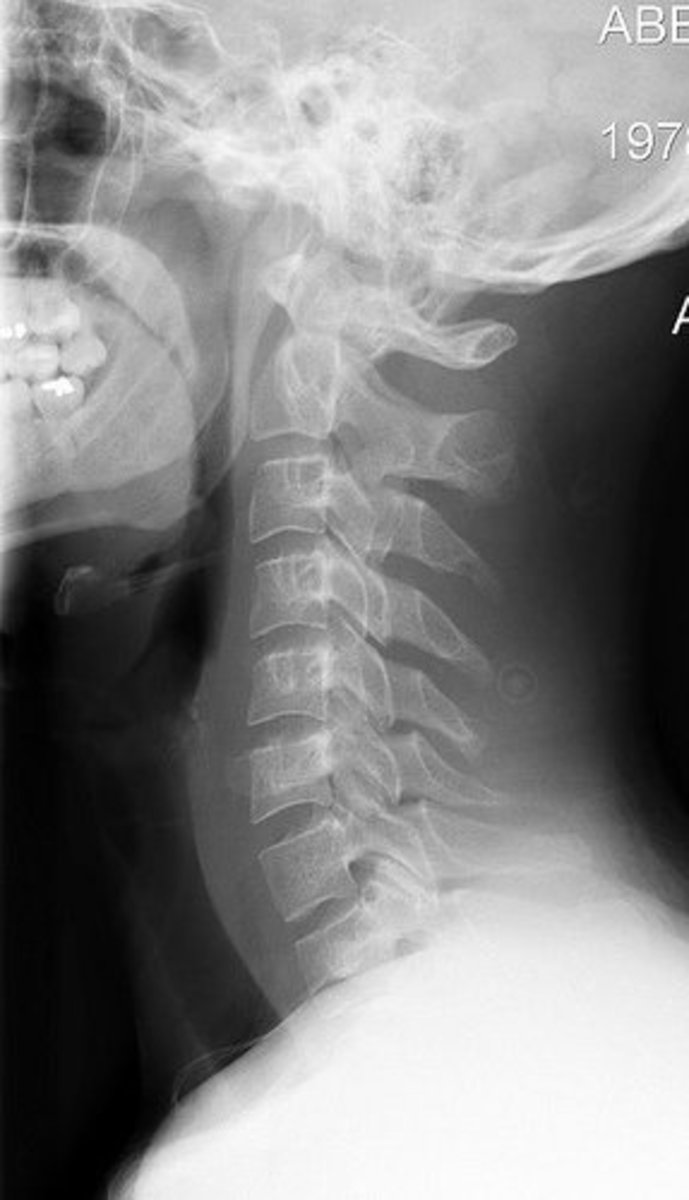Medical Physics
Identify the differences between normal sound and ultrasound.
Normal sound is that which can be heard in the human hearing range, while ultrasound is outside the normal human hearing range. The frequency of normal sound is 20-20000 Hz, and for ultrasound is more than 20,000 Hz, 1-15 MHz for medical use. Normal sound has a longer wavelength and lower frequency than ultrasound, and is more easily scattered by body tissue. Their similarities are in that they are both transverse waves requiring a medium to travel.
Describe the piezoelectric effect and the effect of using alternating current.
The piezoelectric effect is observed through the use of a piezoelectric crystal which is subjected to an external AC voltage; the crystal will consequently oscillate (expand and contract regularly) and produce ultrasound at the same frequency as the applied AC.
Alternatively, it can be observed when it is subjected to radio waves, or ultrasound, which will make it oscillate and build up charges on opposite faces, generating an AC current, or piezoelectricity, between the two faces. In this way piezoelectric crystals can turn electrical energy into mechanical energy, and through it ultrasound; or they can turn mechanical energy into piezoelectricity.
The effect of using an alternating current is that there is the oscillation created, and the frequency of the induced current or ultrasound will match the applied AC.
How is the piezoelectric effect used in medical ultrasound?
In medical ultrasound, an AC current is applied to a piezoelectric crystal in the transducer, causing it to oscillate. Ultrasound waves then travel out the probes in the transducer and are absorbed or reflected by the tissue in the body; they are reflected when they meet a border between two tissues. The reflected waves strike the transducer and cause the crystal to change shape due to the piezoelectric effect. The AC current that is consequently produced reflects the frequency of the echo received, and this can be interpreted by computers to produce an ultrasound picture.
The piezoelectric effect is used in medical ultrasound for non-invasive treatment, such as the breaking apart of kidney or gallstones, and in imaging, such as looking at blood flow in the heart and foetuses.
Define acoustic impedance Z=pv and determine that different materials have different acoustic impedances.
Acoustic impedance is a measure of the opposition of a material or medium to the passage of sound waves, or, in other words, the reflectance of a medium.
It is the density of the material (p) in kg.m^-3 times the speed of sound in v.
A higher acoustic impedance means increased absorption. Air has a low acoustic impedance and is “acoustically soft”; bone, on the other hand, has a very high acoustic impedence and is therefore “acoustically hard” and so reflects almost all sound falling on it.
Acoustic impedence is a measure of how easy it is to transmit sound and the amount of reflection.
Describe how the principles of acoustic impedence, reflection and refraction are applied to ultrasound.
Ultrasound is able to be transmitted, reflected or refracted through the various densities of tissues based on the differences and comparability of the acoustic impedances of the tissues. If there is no different, the ultrasound will be transmitted; where the two acoustic impedances are similar, some sound will be transmitted, and when going from a high density to a low density the sound will refract, similar to light, bending away from the normal. Some sound will also be reflected, and this echo will subsequently be picked up by the transducer. Where there is a very high difference between the acoustic impedance, a lot of sound will be reflected back to the transducer; for example, in an abdomen scan, where it hits the spine.
The areas of no difference in acoustic impedence between the tissues will show up as darker when the computer interprets the reflected sound that is converted to AC current by use of the piezoelectric crystals; areas of comparable acoustic impedances; that is, with some transmission, some refraction and some reflection, will be a lighter shade of grey depending on the strength of the reflected signal. Areas of high reflection and no transmission, such as the spine, will be a bright white as the reflected signal’s intensity is very high. INTENSITY, REFLECTED SIGNAL, DENSITY, ACOUSTIC IMPEDENCE, TISSUE BOUNDARIES, COMPARABLE.
Define the ratio of reflected intensity to initial intensity.
I1/I2=(Z2-Z1)^2/(Z2+Z1)^2
The ratio of the reflected intensity at a tissue boundary is given by the difference between the two acoustic impedances squared divided by the sum of the two acoustic impedances squared; this gives the ratio of the intensity of the reflection of transmitted sound, as a decimal, which is converted to a percentage to give the percentage of incident energy reflected at an interference.
Describe the situations in which A-scans, B-scans and the sector scans would be used and the reasons for use of each.
A-scans involve a single transducer scanning in one line; pulse strength is plotted against time and can be used to measure the size and distance of an organ. MEASUREMENTS. This type of scan is rarely used, but can be useful in measuring growth of a foetus’ head, for example.
B-scans in brightness mode involve an array of transducers in a line, and the points of echoes from each line of transducer come up; the brightness of each point depends on the signal strength, or the intensity of the reflected sound, and the position on time delay. These are used for sector and phase scans.
Sector scans are a series of B-scans with each beam at an angle with the last, which creates the “wedge shape” of ultrasounds of foetuses. In a sector scan, the transducer is often rocked back and forth to get an image from different angles.
Alternatively, a phase scan is used which is a series of B-scans at angles to the last, with each transducer sending pulses at time intervals for a different phase of each signal; these can be electronically controlled for a sector scan. These are used for cardiology and abdominal imaging.
Describe the Doppler Effect in sound waves and how it is used in ultrasonics to obtain flow characteristics of blood moving through the heart.
The Doppler Effect is the perception of apparent change in the frequency of a sound wave with relative motion; approaching sound appears to be becoming higher in pitch, or with a greater frequency, while sound moving away appears to gain a lower frequency.
This is used in medicine when the detected frequency is modified by the movement of tissue, or blood flow. For example, if blood cells are moving towards a transducer, the frequency of the returning signal will be different to that of the sent signal, allowing a measurement of the speed of the wave.
This principle is used for located blockages, where the Doppler Effect is not noted or experienced to a less satisfactory extent, determining a lack of blood flow; it can also be used for the monitoring of a foetus’ heart.
In order to map the blood flow through ultrasound, false colour is applied to signals, so different speeds and directions have different colours and colour strengths, allowing visual understanding of blood flow to diagnose problems.
Outline some cardiac problems that can be detected through the use of the Doppler Effect.
An endocardiogram is an ultrasound of the heart in 2D images. Doppler endocardiography is when an ultrasound bean parallel to blood flow reflects off individual blood cells moving towards or away from the transducer to measure the velocity and direction of blood flow. This principle can be used to measure Ventrical Septal Defect, or a hole in the heart that may result in abnormal blood flow; it can be used to detect narrowing arteries where blood flow inexplicably decreases; leaking valves where the blood is flowing in the wrong direction, and blockages and build-up of plaque, restricting blood flow. In these ways cardiac problems can be detected by endocardiograms using the Doppler Effect.
Describe how ultrasound is used to measure bone density.
Osteoporosis is a disease characterised by bone density which leads to decreased bone strength.
A method called DEXA is the most accurate current way to determine bone density by measuring the absorption of X-rays; however there is also the QUS method which measures the energy loss and the velocity of ultrasound waves travelling in one direction through the heel bone; while able to measure bone quality, however, it cannot measure bone density or strength, and is rather used as a screening tool. For this reason it is an initial test for osteoporosis and patients often go on to the DEXA method to determine bone density. However, recent studies have found it may be cheaper to go straight to DEXA, it is not harmful as it uses less radiation than dental x-rays. THIS MAY IMPROVE AS TECHNOLOGY IMPROVES.
Describe how x-rays are produced.
X-rays can be thought of as high-energy photons or quanta on an atomic scale. They are produced in an evacuated tube with a cathode at one end and an anode at another with a target made of a material with a very high melting point, such as Tungsten. Electrons are accelerated at velocities of 100keV by heated a cathode, and they are attracted to the positively charged anode and hit the Tungsten target, interacting with the electrons in the Tungsten atoms to emit X-ray radiation.
X-rays are produced on a continuous spectrum, with some strong, narrow emissions called characteristic x-rays.
Continuous spectrum xrays are produced when electrons hit the Tungsten target; as they interact with the positively charge nuclei of the Tungsten atoms, they are attracted it, resulting in a change in direction. This change in direction is interpreted as acceleration and a change in velocity, and the acceleration of these subatomic particles results in the emission of radiation as xrays. This is known as Bremsstrahlung, or braking radiation, and occurs because of the law of conservation of energy. As Ek1=Ek2+hf (energy of emitted photon, or xray); Ek1 is the incoming electron, Ek2 is the energy of the deflected electron, and since the energy of the deflected electron has changed due to its change in direction, its energy is converted to a photon, or x-ray.
Characteristic xrays, which are shown as spikes in the energy of rays, are also known as line spectrum xrays and are less common than the continuous spectrum ones. The line spectrum xrays are produced when an electron is attracted to a nucleus of a Tungsten atom and consequently knocks an electron of the Tungsten atom out of its shell, with both electrons being sent off in different directions. This results in an electron from a higher shell falling down towards the attractive positive nucleus to the other electron’s “hole”; to do so the fallen electron goes into a lower energy state, and due to the law of conservation of energy a high-energy photon, or x-ray, is emitted. K-line and L-lines, depending on which shell the electron is knocked out of.
Compare hard and soft x-rays.
Hard x-rays have a greater frequency and shorter wavelength than soft ones; they are produced using higher voltages. They have more energy in photons and therefore have higher penetration and less absorption, leading to their being less harmful to the body; they also produce better quality xrays due to the great penetration.
Soft x-rays, being more easily absorbed and therefore more harmful than hard xrays, are sought to be reduced by increasing the applied voltage in the cathode ray tube, thus increasing the energy of the electrons and their acceleration; moreover, they can be reduced by passing the beam through a filter of aluminium to dissipate low energy rays.
What are practical considerations of x-ray production?
Soft x-rays must be avoided as they are more harmful to the body and hard xrays produce better quality images; this is described above.
Moreover, x-rays have a very low efficiency rate, with 99% of the electrons energy being converted to heat rather than x-rays; due to this, the anode and target get very hot and therefore a system of cooling oils must be circulated through the anode with cooling fins of copper. Moreover, Tungsten is often used as the target for x-rays as it has a very high melting point and can take the heat created by the electrons’ energy conversion.
How are x-ray images created for medical diagnosis?
X-ray machines have collimators to control the size and shape of x-ray beam. Beams that don’t get absorbed and don’t pass through get scattered, making the x-ray image fuzzy, and therefore a grid of lead is used before the beam hits the screen so only transmitted and not scattered x-rays fall on the photographic film below the patient. A screen is used to convert x-rays to visible light, which exposes the film. This is so there is a smaller exposure time to the xrays needed for the patient.
Explain how a computed axial tomography is produced.
Computed Axial Tomography, or CAT scans, are produced by placing a patient on a bed that is the axis of a large gantry, or donut-shaped machine. This gantry fires a narrow, fan-shaped beam of xrays at the organ or area being scanned, and the x-rays are absorbed or transmitted by the tissue, depending on the tissue type. While this happens, the gantry spins around the axis while the bed moves through it, allowing images to be taken in “slices” and from all angles.
Detectors, crystal photodiodes, measure the amount of x-rays that passed through, and a computer uses an algorithm to analyse data and create the “slices” that can build a three dimensional picture of the organ.
The image is made up of “pixels” which represent 1mm by 1mm of tissue each and range from black, numbered 1 and white, numbered 256, depending on the amount of absorption of xrays; it is also made up slices, which are called voxels and are 3-5 mm thick.
CAT scans are used to detect tumours, infections, bone fractures and blood clots. The patient can be injected with iodine or barium sulphate to improve the contrast between an organ and the surrounding tissue for better imaging.
Describe circumstances where a CAT scan would be a better diagnostic tool compared to x-ray or ultrasound.
While x-rays show all the structures in the x-ray’s path, for example the ribs when trying to look at lungs, CAT scans scan all around a patient and obstructions can be digitally removed for better visibility. Moreover, CAT scans are more sensitive and show contrasts between types of tissues more readily, allowing more reliable diagnostics; they have 256 shades of grey as opposed to 30.
CAT scans can distinguish between white and grey matter in the brain and spinal fluid, and can penetrate bone and gas, which ultrasound cannot. However, they are more expensive.
Explain how an endoscope works in relation to total internal reflection.
Endoscopy is the use of a fibre optic endoscope to examine the interior of a body through an opening, either natural or by incision. An endoscope is a long tube is made up of fibre optic cables, which have two layers of pure glass; the core has a high refractive index and the cladding a lower refractive index. Because of this, the light travelling from the more dense material to the less medium creates refraction as it bends away from the normal, until the angle of incidence is 90 degrees at the boundary of the materials, at which point the light does not penetrate the less dense material and instead bounces along the core, causing total internal reflection. A plastic sheath around the glass allows no light to escape to surrounding fibres.
This principle is used in endoscopy as it allows images to travel down the fibre optic cables to a computer, giving insight into the organs or inner materials of a body.
Discuss the differences between the roles of coherent and incoherent bundles of fibres in an endoscope.
Medical endoscopy as imaging utilises coherent bundles, which means the optic fibres are arranged in the same relative position at the both ends of the endoscope. They are used to transmit the image without distortion. The amount of detail that can be seen is determined by the number of fibres and their thickness, as diffraction limits the minimum thickness of the fibre. Incoherent bundles are arranged randomly and are used to transmit light to illuminate the organ needed.
Flexible fibre endoscopes contain an incoherent light guide, a coherent image guide, a water pipe to keep the endoscope clear, a channel for suction of gas exchange and an operations channel to insert mini surgical instruments.
Explain the medical uses of an endoscope.
An endoscope can be used for observing internal organs by directing the end of an endoscope to the area, for example the stomach or colon. The doctor sees the transmission and can make diagnoses.
An endoscope can also be used for a biopsy, or to obtain tissue samples for testing. A cable running the length of the endoscope has mini surgical instruments attached, including biopsy forceps which can take tiny samples; wires with electric current can also be used to cauterise blood vessels.
Describe how radioactive isotopes may be metabolised by the body to bind or accumulate in the target organ.
Radionuclides contain radioactive isotopes of elements that are naturally found in the organ or tissue being examined. These are injected or inhaled by the patient, and they behave exactly like the element in the body by accumulating and taking part in the natural system of the body, except their radioactivity makes them traceable by gamma camera outside the body. The radionuclide creates “hot” and “cold” spots detectable by the gamma ray cameras, with hot spots being increased movement and concentration, showing up darker in scans, and cold spots being an absence, showing up lighter. In this way irregularities can be mapped and diagnosed. This nuclear imaging works well with bone and soft tissue.
Outline properties of radioisotopes and their half-lives that are used to obtain scans of organs.
Radioisotopes are produced in particle accelerators such as a cyclotron; there are 400 artificial radioisotopes known to exist. They have a half-life, which is the time for half the given mass of an element to decay into new elements. Natural radioactivity is exhibited by all the elements above bismuth on the periodic table. Artificial radioactivity can be made with bombardment of alpha particles. They should be pure gamma or pure beta emitters, preferably gamma as it passes through the body and is not harmfully absorbed. Moreover, radioisotopes should have a short half-life as this allows them to die about before being harmful to the patient.
Discuss radioactivity.
Radioactivity is the simultaneous breakdown of an element into another element by emission of alpha, beta and gamma rays. Alpha rays have a double positive charge, are four times the mass of a proton and have strong ionisation effects; they are easily absorbed by just a sheet of paper and have very slight deflection in an electric plate. Beta rays have a positive charge and are 1/1800 times the mass of a proton; they have weak ionisation properties and are somewhat absorbable being absorbed by a 5mm sheet of aluminium; moreover, they are greatly deflected by electric plates.
Gamma rays are like electromagnetic waves and have a neutral charge and no mass. They have very weak ionisation effects and are never fully absorbed, although their intensity is weakened by 25 mm of lead. They cannot be deflected by an electric plate.
Compare an image of a bone scan with an x-ray.
An example of nuclear imaging is a bone scan, which uses the radioisotope Technetium-99m; this isotope is used because of its short half-life of 6 hours and emission of pure detectable gamma rays, as well as the fact that its parent nuclide can continue producing it for a week before it needs replenishing. This can be useful in detecting stress fractures, metastases, and bone cancer, arthritis or bone infection. Unlike an x-ray, radioactivity travels outside the body and is detected by cameras, whereas in an x-ray it goes through a patient and falls on a film.
Similarly, Iodine-131 with a half-life of 8 days is used for thyroid imaging. Gallium-67 is used for soft-tissue tumours, with a half-life of 72 hours.








